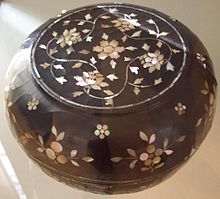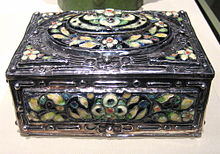- Decorative box
-
Though the purpose of a box may be purely functional, boxes can also be very decorative and artistic. Many boxes are used for promotional packaging, both commercially and privately. Historical objects are usually called caskets if larger than say a shoebox, with only smaller ones called boxes.
Contents
Gift box
Traditionally gift boxes used for promotional and seasonal gifts are made from sturdy paperboard or corrugated fiberboard. These boxes normally consist of a base and detachable lid and are made by using a die cutting process to cut the board. The box is then covered with decorative paper. Gift boxes can be dressed with other gift packaging material, such as decorative ribbons and gift tissue paper.
Work box
The most common type of decorative box is the feminine work box. It is usually fitted with a tray divided into many small compartments for needles, reels of silk and cotton, and other necessaries for stitchery. The date of its origin is unclear, but 17th-century examples exist, covered with silk and adorned with beads and embroidery.
No lady would have been without her work box in the 18th century. In the second half of that century, elaborate pains were taken to make these boxes dainty and elegant.
Work boxes are ordinarily portable, but at times they form the top of a stationary table.
A jewelry box, also known as a casket, is a receptacle for trinkets, not only jewels. It may take a very modest form, covered in leather and lined with satin, or it may reach the monumental proportions of the jewel cabinets which were made for Marie Antoinette, one of which is at Windsor Castle, and another at the Palace of Versailles; the work of Schwerdfeger as cabinetmaker, Degault as miniature-painter, and Thomire as chaser.
Snuff box
"Snuff box" redirects here. For the BBC3 comedy, see Snuff Box. For the anatomical location within the hand, see Anatomical snuff box. Coffin-shaped (mourning?) snuff box made from sheet copper, raised, tinned inside and engraved. It is English and is dated 1792.[1] Victoria and Albert Museum, London
Coffin-shaped (mourning?) snuff box made from sheet copper, raised, tinned inside and engraved. It is English and is dated 1792.[1] Victoria and Albert Museum, London
One of the more functional types of decorative boxes is the snuff box, which is now largely a relic of the once popular practice of taking snuff. These tiny, decorative, utilitarian boxes were an indispensable accessory for many upper-class people from the 18th century through the middle of the 19th century. Since prolonged exposure to air causes snuff to dry out and lose its quality, pocket snuff boxes were designed to be airtight containers with strong hinges, generally with enough space for a days' worth of snuff only.[2]
Certain gentlemen, fops, and dandies possessed a variety of fancy snuff-boxes created by jewellers and enamellers. Some of these were rich in detail and made from precious materials, such as gold and diamonds. Other boxes were more ordinary; some were even made with potato-pulp, the cheapest wood-like material available.
Other popular materials used in making these boxes include:
- Tortoise-shell, a favorite material owing to its satin lustre;
- Mother-of-pearl, which was kept in its natural iridescent state, or gilded, or used together with silver; and
- Gold boxes, enriched with enamels or set with diamonds or other precious stones.
The lids were often adorned with a portrait, a classical vignette, portrait miniature, hardstone inlays, or micromosaic panel. Some of the most expensive just used subtly different colours of gold.
Even after snuff-taking ceased to be popular in general, the practice lingered among diplomats. Monarchs retained the habit of bestowing snuff-boxes upon ambassadors and other intermediaries as a form of honor. As Talleyrand explained, the diplomatic corp found a ceremonious pinch to be a useful aid to reflection in a business interview. At the coronation of George IV of England, Messrs. Rundell and Bridge, the court jewellers, were paid £ 8,205 for snuff-boxes for gifts to foreign representatives.
Today snuffboxes are collected at many levels - at the top of the market they tend to be called "gold boxes". The most expensive are French and German 18th century examples, and the record auction price for a German box is £789,250 (about US$1.3 million), bid in 2003 at Christie's in London.[3]
Strong box
A strong-box is a receptacle for money, deeds and securities. Its place has been taken in modern life by the safe. Some have extremely elaborate locks, such as Sir Thomas Bodley's strong-box in the Bodleian library, which has a locking mechanism in the under-side of the lid.
Knife box
In the Middle Ages people usually brought their own cutlery with them when eating away from home, and the more expensive types came with their own custom-made leather cases, stamped and embossed in various designs. Later, as cutlery became provided by the host, decorative cases, especially for the knives, were often left on display in the dining-room. The knife-box or knife-case, a receptacle for knives and other table cutlery, is one of the most charming of the minor pieces of furniture which we owe to the artistic taste and mechanical ingenuity of the English cabinet-makers of the last quarter of the 18th century. Some of the most elegant and often ornate were in the styles of Robert Adam, George Hepplewhite and Thomas Sheraton. Occasionally flat-topped containers, they were most frequently either rod-shaped, or tall and narrow with a sloping top necessitated by a series of raised veins for exhibiting the handles of knives and the bowls of spoons. Mahogany and satinwood[disambiguation needed
 ] were the woods most frequently employed, and they were occasionally inlaid with marquetry or edged with boxwood. These graceful receptacles, often made in pairs, still exist in large numbers; they are often converted into stationery cabinets. Another version is an open tray or rack, usually with a handle, also for the storage of table cutlery.
] were the woods most frequently employed, and they were occasionally inlaid with marquetry or edged with boxwood. These graceful receptacles, often made in pairs, still exist in large numbers; they are often converted into stationery cabinets. Another version is an open tray or rack, usually with a handle, also for the storage of table cutlery.Bible box
A Bible box is a box made to hold a Bible. These boxes started being manufactured in the 17th century.[citation needed]
Étui
An étui is a woman's ornamental case, usually carried in a pocket or purse. It holds small tools for daily use such as folding scissors, bodkins, needles, hairpins, tweezers, makeup pencils, etc. Some étuis were also used to carry doctors' lancets. These boxes were made of different materials such as wood, leather, ivory, silver, gold, tortoise shell, mother of pearl, and shagreen.
Wooden wine box
Wooden wine boxes, also known as wooden wine crates are used to ship and store expensive wines in transit. Most wineries that use wooden boxes engrave their logo and designs on the front panel. These panels are usually highly detailed and used by wine collectors as decoration pieces for their bars or wine cellars. A typical wooden wine box holds either six or twelve 750 ml bottles.
References
- ^ "Snuff box". Metalwork. Victoria and Albert Museum. http://www.vam.ac.uk/images/image/10121-popup.html. Retrieved 2007-08-18.
- ^ http://www.snuffbox.org.uk/hto.htm
- ^ Christie's
Categories:- Collecting
- Containers
- Domestic implements
Wikimedia Foundation. 2010.




